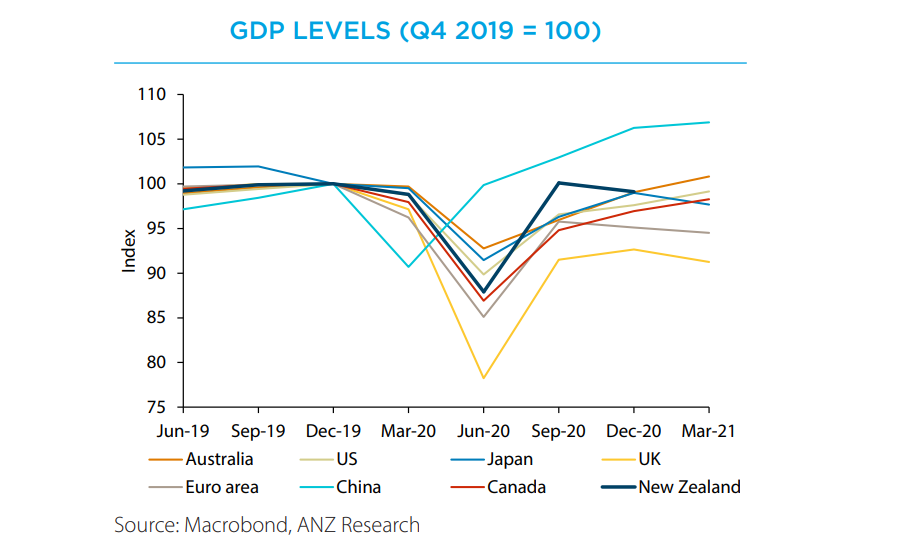-
New Zealand’s economy is recovering although the road ahead is still highly uncertain. Notably, supply chain disruptions continue to create challenges moving goods around the world.
New Zealand is one of the best-performing economies among its key trading partners primarily because it had success eliminating and keeping out COVID-19 due to its isolation and tight border controls.
"Much of the NZ economy is back operating at full steam, largely making up for the sectors still lagging.”
{CF_IMAGE}
Much of the NZ economy is back operating at full steam, largely making up for the sectors still lagging. The change brought about by the pandemic was very abrupt and altered both the level and the composition of spending in NZ and overseas.
Consumption globally has been bolstered by an unprecedented amount of temporary fiscal support. With many economies locking down, people have naturally traded restaurant/experience/travel spending for purchases of more stuff, particularly online.
This compositional shift towards manufactured goods was unexpected and abrupt and it’s creating significant headaches for global supply chains, seeing shipping costs lift – significantly.
In time
Supply chain disruption is challenging the world’s ‘just-in-time’ approach, a dominant feature of global trade these past few decades. Reduced air cargo means there’s more for ships to carry and port congestion mean ships are spending too much time sitting idle.
How long these disruptions persist is anyone’s guess but global inventories will eventually be rebuilt (and possibly kept permanently higher) and supply chains ironed out.
That could happen as soon as the end of this year but more likely the supply challenges will persist well into 2022.
As cost pressures unwind NZ should see inflation pressures ease both locally and around the globe, which is why policymakers are looking through inflationary pressure for now. There is no doubt the NZ economy has performed much more strongly than anyone dared hope.
Much of the strength in the economy can be attributed to a handful of key factors. Among them a successful containment of COVID-19 which has provided kiwis the freedom and confidence to go out – and spend.
Additionally, fiscal policy stepped up to the plate, essentially putting a healthy chunk of the second quarter’s lost production on NZ’s balance sheet - largely via the wage subsidy – which meant incomes did not fall anywhere near as much as production GDP did.
Finally, low interest rates have stimulatied the economy – admittedly largely via housing, as opposed to business investment.
Economic growth is expected to remain subdued through 2021 but pick up in 2022 as global economies improve and fewer border restrictions allow growth in sectors of the economy that are severely stifled at present, such as tourism and foreign education.
Cost pressures associated with the supply disruption are expected to eventually dissipate and give way to a demand-driven lift in inflation. This will be driven by a tightening of other resources including labour and natural resources
Helping out
The combination of monetary policy support and fiscal stimulus has provided a significant cushion to the economy which has helped facilitate the vigorous bounce-back seen to date.
On the monetary side, the RBNZ cut the official cash rate to a record low, implemented new asset-purchasing and lending programs and prepared the banking system for negative interest rates if required.
On the fiscal side, stimulus has been most potent from the wage subsidy which protected jobs and incomes and provided a degree of certainty during disruption, albeit at enormous cost. A range of other temporary policy supports accompanied it.
Now that the wage subsidy has rolled off, fiscal policy is pivoting towards the likes of infrastructure spending, which will support the level of economic activity.
Overall, monetary and fiscal policy settings are expected to be expansionary for a while yet. ANZ Research expects the RBNZ will maintain a cautious approach to removing stimulus in line with their least-regrets approach.
Policy normalisation will be a gradual, multi-year process. The RBNZ is forecasting they will start lifting the overnight cash rate (OCR) in August 2022, which is consistent with ANZ’s forecasts. Risks are skewed to this being a little earlier but the RBNZ will want to wait for the data to settle before kicking off a tightening cycle.
Assuming no dramatic developments in terms of COVID or global financial markets, wage growth and inflation expectations are the key data to watch in terms of the medium-term inflation outlook and therefore the likely path for the OCR and interest rates more generally.
Susan Kilsby is an Agriculture Economist and Sharon Zollner is Chief Economist NZ at ANZ
This story was originally published on ANZ’s Institutional website.
The views and opinions expressed in this communication are those of the author and may not necessarily state or reflect those of ANZ.
-
anzcomau:Bluenotes/global-economy,anzcomau:Bluenotes/COVID-19
New Zealand: operating at full steam
2021-06-10
/content/dam/anzcomau/bluenotes/images/articles/2021/June/KilsbyZollnerEconomy_banner.jpg
EDITOR'S PICKS
-
New Zealand handled the health and economic impacts of COVID-19 with resilience – leading to a strong financial result for the bank.
5 May 2021 -
New Zealand Chief Economist, Sharon Zollner provides the data on how the land of the long white cloud is making its way to a COVID normal.
9 October 2020

